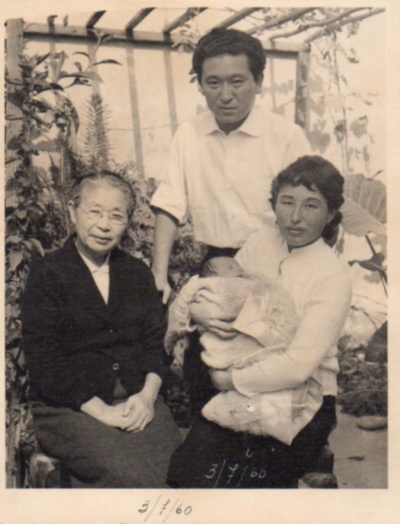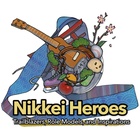As we commemorate 120 years of Japanese immigration to Peru, I'd like to share a personal reflection inspired by the immigration story of my great-grandmother, who has been an enormous source of admiration for me both as a person and as a woman. Her story is probably similar to that of many other women, a story that is so rarely told. I’m going to take this opportunity to tell it, since it has been 120 years since the Sakura Maru arrived in Callao.
My great-grandmother, Yoshino Sakurai, was from a small town in the mountains called Ojiya, in Niigata. Because she was born in the midst of the Meiji Restoration, the winds of change as traditional ways of life gave way to modern ones, molded her as a woman who was very much ahead of her time. Not only did she dare to participate in activities that were traditionally masculine, like skiing, she also earned a college degree. In fact, she studied at an institute for women in Nagaoka, which is now a campus of the University of Niigata. She studied education.
Why did she emigrate? Her family had an onsen in Ojiya, so it is fair to say that she had a happy life in Japan, unlike many of the immigrants who were forced to leave their homeland in search of a better life. Why leave, then? At that time, there was something called yobiyose or a call to migrate. A man named Shohei Hoshi, who was originally from Niigata but lived in Peru, was seeking a wife. And since apparently the Sakurai family owed an honor debt to the Hoshi family, they sent their daughter to marry him.
In retrospect, I can imagine the pain and horror of being forced to marry a complete stranger, on the other side of the ocean, in a country she had never seen, where they spoke a language she did not know. She left behind her family, friends, dreams, and all of her customs because a man on another continent wanted her to, and worst of all she had to obey because she was a woman, and her purpose in life was to marry and bring honor to her family. Refusing that opportunity meant going against everything she had been taught. That’s how she arrived in Lima in 1912, at the age of 21, almost as old as I am. It seems horrible to think that person could have been me. She was forced to give up many things, including her own identity. No longer called Yoshino, she was given a new name: Leonor.
But throughout history, women have found ways to get what we need behind the facade of masculine power. This was no exception. Together, Shohei and Yoshino opened the Hoshi School (星学園) for immigrants and their children, where she became a teacher. It was, in fact, one of the first schools focused on providing a Japanese education to those living far from their homeland, and they often provided this service free to the many poverty-stricken immigrants. Today, the school is located in the Mercado Central shopping center, close to Mesa Redonda.
Within a few years she became a widow with 10 children and a school to maintain. She then became the school's director (she may have been doing that before, but unfortunately I don’t know the full story), and began working hard to make sure all of her children had the chance to succeed. She was a foreign woman working alone in an unknown and basically masculine world. I don’t know how she did it, but she succeeded. She was even recognized by the Government of Japan in 1939 for her work and service to the Japanese community in Peru. Unfortunately, the school closed as tensions rose leading up to war, and eventually she was deported and then sent back to Japan in exchange for U.S. soldiers, because they thought she had too much influence as a Japanese woman. When she returned from the horrors of the internment camps in Texas and the bombing in Japan, the world was a very different place. She then retired from her career and spent the rest of her life enjoying the fruits of so many years of untiring work and service, until she died in the 1960s.
I believe 感謝 ('kansha' in Japanese, or 'gratitude') is the best word to describe the patchwork of emotions I feel when thinking about her life story. I think that all Japanese descendants must feel something similar, because in every personal story there is a tenacity to cling to life and move forward based on one's values and honorable work, despite the terrible circumstances of one's life. What we are and where we are now is the result of the arduous work, sometimes fighting tooth and nail, of the people before us who arrived in a foreign country with only the clothing on their backs.
I always found it difficult to connect to my Japanese past. When I look in the mirror I don't hardly see any physical characteristics. I speak Spanish and my Japanese surname comes from my mother's family. However, learning about my great-grandmother's story gives all of that a different meaning for me, with respect to who I am, where I come from, and who I want to be as a woman and as a person.
Now that it has been 120 years since the first Japanese immigrants arrived in Peru (most of whom, in fact, came from Niigata), I think it’s a good opportunity to reflect on how our past has shaped our present, and to be thankful for that. Finally, it’s also part of our identity. It's somewhat (very) difficult to say what it means to be Nikkei, but I can say with confidence that the kimochi that is shared is what has made us strong as a community, the same way that it was for our ancestors who struggled to build a life for themselves.
My great-grandmother was described as 海を渡った女先生 ('the teacher who crossed the ocean') in a newspaper article published in Niigata in 1999, commemorating 100 years since the emigration of Japanese people to Peru. I hope that if my great-grandmother can see what has become of her descendants, wherever she is, that she feels proud of what she cultivated with her example and her tenacity.
どうもありがとうございます!

© 2019 Kyomi Vargas Hoshi



